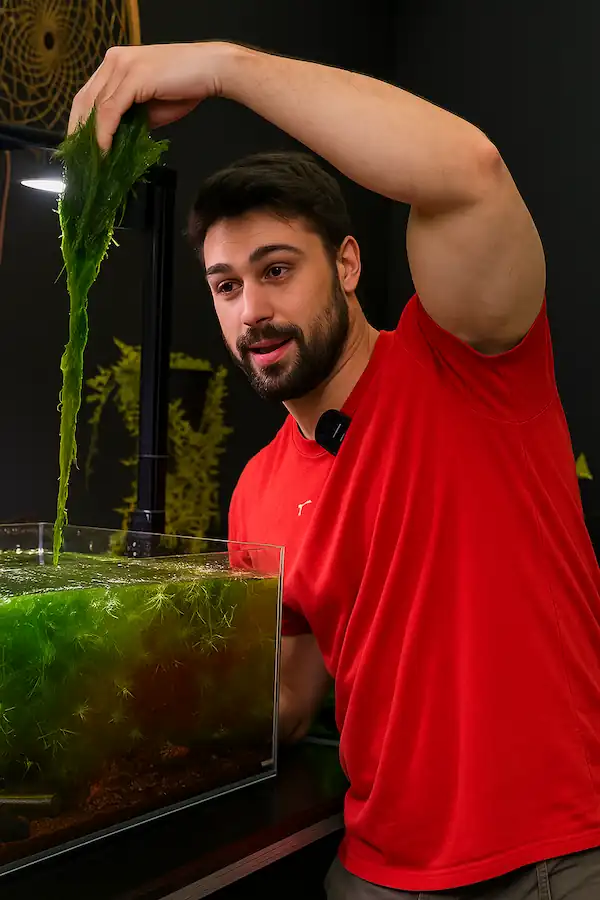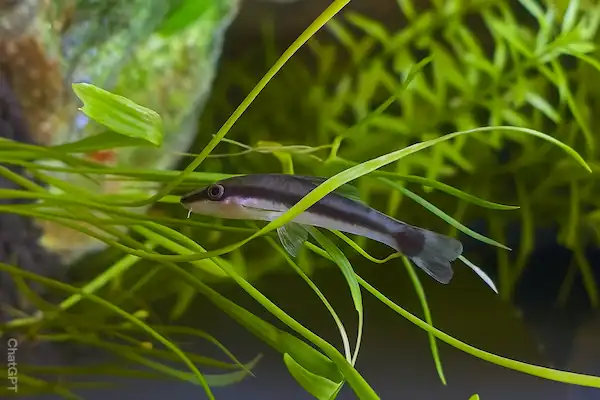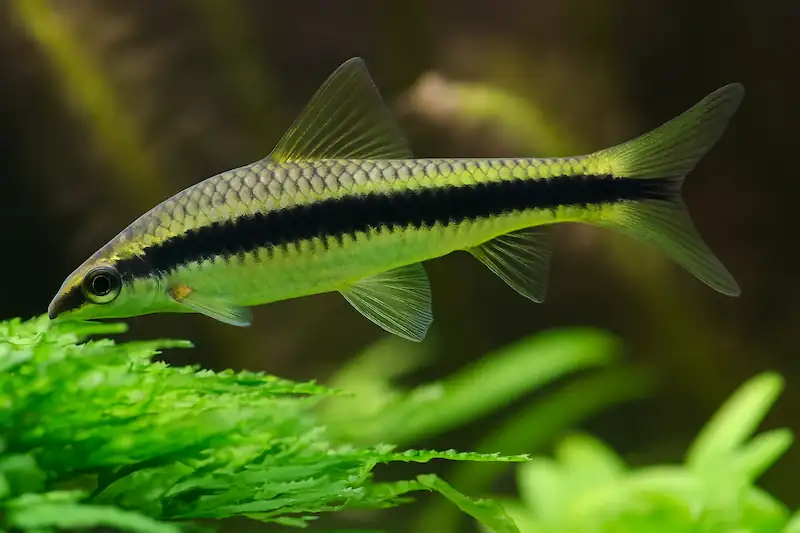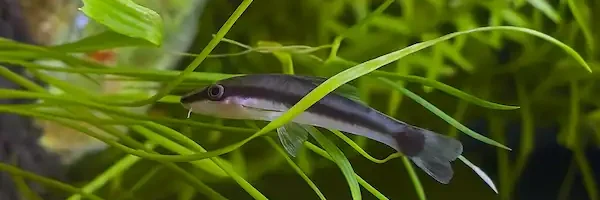If you keep fish aquariums, you’ll definitely come across algae. Most fishkeepers remove it as soon as it begins to accumulate in the tank. Algae in a betta fish tank are not as toxic as other harmful chemicals, such as ammonia and nitrates. However, if they grow in the tank for a long time, they can cause problems for both the fish owner and the fish itself. Algae can turn the water cloudy, making your setup look dull and messy. That’s why they should be removed when they develop excessively.
While combating algae in a betta tank, you may have tried cleaning, scrubbing, or changing the water. But somehow the algae always come back. Controlling it with chemicals can further create issues for your betta fish. That’s where natural algae eaters come in. These are tank mates that not only add extra life and personality to your aquarium but also work as a tiny cleaning crew.
Common Algae Types
To deal with algae blooms in your betta tank, you first need to know the different types, as each has its own removal method. The most common types of algae found in betta tanks are listed below.
1. Green Algae
Green algae usually grow when your tank gets too much light. If you leave your aquarium light on for too long or put the tank where sunlight hits it directly, you’ll likely see green spots or a fuzzy green layer forming on the glass, decorations, or plants.

Green algae typically exist in two forms. One is green dust algae, which appears as small, hard green dots on the glass or plants. The other is green dust algae, which appears as a soft, powdery green coating. To tackle both algae, nerite snails or otocinclus catfish are effective in doing the job.
In small amounts, green algae aren’t dangerous. They can even be a sign of a healthy tank. But if they spread too much, they make the tank look messy and block light from the plants. To control it, reduce the duration of aquarium lighting.
2. Brown (Diatom) Algae
The brown algae aren’t really algae; they’re called diatoms. It typically grows in betta tanks when there’s a high concentration of silicates in the water, rather than excessive light or ammonia. Brown algae appear in new tanks or when you add new decorations, filters, or plastic stuff.
It’s very common in the first few weeks or months of a tank. The bad news: you can’t totally stop it overnight. The good news is that it goes away on its own once the silicates are used up. Until then, scrub it off and continue with regular water changes.
3. Hair Algae
It’s a thin, stringy, green stuff that grows very quickly. Once it wraps itself around plants, it isn’t easy to deal with them. It results in starving the plants. Remove them soon, as they build up in your aquarium. Amano shrimp love to eat it. To control manually, pull it out by hand or twirl it around a toothbrush.
Beyond Fish, Simple Ways to Keep Algae Away
It’s an undeniable fact that algae eaters are great helpers in wiping out algae. However, if you don’t address the underlying cause, it will continue to recur. To address the root cause and maintain a cleaner tank over the long term, it is essential to resolve these issues.
Manage Your Lighting
Algae love light, so don’t give it more than it needs. Usually, the tank light is recommended to be on for 12-14 hours. But if the algae grow rapidly, keep it on for about 6–8 hours a day. Avoid placing the tank in a location that receives direct sunlight.
Feed Smart
Only feed what your fish can finish in 2–3 minutes. Scoop out any leftovers right away so they don’t rot and instead feed the algae.
If your algae eater doesn’t have much algae to munch on, make sure you give them the right extra food. Each species has its own favorites, from algae wafers to blanched veggies.
Keep Up with Water Changes
Perform regular partial water changes (about 25–30% once a week) to keep nitrates and phosphates in check, as these are algae’s favorite snacks.
Every new fish or snail you add increases the tank bioload, so watch your water quality closely afterwards.
Add Live Plants
Plants are like natural algae competitors. They soak up the same nutrients algae need, i.e., nitrates. Live plants make the tank more visually appealing, provide oxygen, and offer hiding spots for shy tank mates.
Test Your Water Regularly
Regularly testing your water will keep your tank safe from excessive algae buildup. Similar to nitrates, a higher pH can result in the production of an algae bloom. A good aquarium master kit will help you monitor pH, ammonia, nitrite, and nitrate levels.
Manual Removal of Algae
Even with all this, if the algae still isn’t going away, you may need to remove it by hand or use a toothbrush. I prefer an algae scraper because it leaves the glass walls crystal clear. If algae has built up on decorations, it’s best to tackle it with the scraper or a cleaning pad.
Algae often hides in spots you don’t notice, such as silicone seams or top edges, so be sure to wipe down the tank rims and corners as well. If it’s growing on plant leaves, gently rub it off with your fingers or trim the worst-affected leaves.
Things to Consider While Choosing Algae Eaters
Before adding any algae eater to a betta tank, you’ve to take care of certain things. There are several considerations to consider, including betta compatibility, tank size, the role of decor, and hiding spots.
Betta’s Compatibility
Many fishkeepers often ask, can algae eaters live with bettas? The short answer to the question is yes, they live with betta fish, but it depends on the temperament of your betta fish and the algae eater you add.
Bettas are the kings of their aquariums. They won’t accept just any tank mate you add. They only get along with peaceful and safe companions. Therefore, it’s important to consider your betta’s compatibility with any algae eater you introduce. Otherwise, while your betta might not kill the algae eater, it can still cause serious harm.
Tank Size
For a single betta, a 5-gallon tank is the bare minimum. But if you want to add other fish or algae eaters, it’s best to go for 10 gallons or more. Along with many other benefits, larger tanks offer, they prevent violence in setups with multiple fish. They give everyone more room to swim and make it easier to keep the water clean because waste gets diluted more effectively.
Environment in the Aquarium
Aquariums with multiple water dwellers require more effort in terms of maintenance. You won’t just ensure the right conditions for your betta, but also for other algae eaters. Maintain levels of all substances, including ammonia, nitrate, and nitrite, within acceptable ranges. Avoid sudden changes in their levels to prevent your aquarium creatures from facing stress.
Bettas and their tank mates require plants, caves, driftwood, or other decorations to break up the sightlines and provide them with places to hide. This not only makes the tank look great but also helps everyone feel safe, reducing the chances of aggression.
Choosing Right Algae Eaters for Your Betta Tank?
Numerous algae eaters are recommended for betta tanks. Whatever you pick, consider their size, personality, needs, and many other factors when keeping them in betta tanks.
The factors that are looked for the most are the temperament and the size of these algae eaters. Some algae eaters appear small in the store but grow large enough when kept in a betta tank. That’s why you should search for its adult size. Next, they should be peaceful and mind their own business. Avoid species that nip fins or get territorial. Select the species that will remain comfortable in your tank for a long time, not one that will outgrow and need rehoming later.
Ensure your chosen algae eater prefers the same water conditions as your betta, including a similar temperature, pH level, and water hardness. If their needs are very different, one of them will suffer.
Top Algae Eaters That Work with Betta
Not every algae eater will get along with your betta or fit in your tank. After studying their nature, temperament, size, and other factors, I’ve put together a list of the top algae eaters. I’ve tested and kept most of them in my own tank, and I’m confident they can help keep your aquarium clean without causing trouble, provided you take the right precautions.
1. Nerite Snails (Zebra, Horned, Tiger)
Nerite snails are my first choice, which I have added to my 10-gallon betta tank. They are peaceful, low-maintenance, and don’t suddenly take over the tank. Nerite snails stay small in size and don’t interact too much with the betta fish. Therefore, they are considered suitable algae eaters for a 5-gallon betta tank.
I have found them great at polishing off green spot algae and diatoms. The good thing about these snails is that they create a small bioload and won’t overwhelm your filter. Plus, they don’t breed extensively in freshwater as their eggs hatch only when they live in blackish water. However, their unfertilized eggs may be visually unappealing.
To feed nerite snails, add calcium supplements as needed to keep their shells strong. Fit the lid of the tank securely so they can’t climb as they have the instinct to do so.
2. Otocinclus Catfish (Oto Cats)
These tiny catfish are like vacuum cleaners for brown diatom algae and green dust algae. They are calm, active, and entirely harmless for bettas. Oto cats are considered great for bettas because they have a very gentle nature. It’s fun to watch them while they eat soft algae.

They should be in a group of at least 3-5 to feel safe. They do best in mature tanks with a steady supply of biofilm. But they are sensitive to water changes, so keep your parameters stable.
3. Amano Shrimp
Amano shrimp of our addition to a 20-gallon betta tank. Since they work overtime with constant foraging, we have added a larger tank. They’re non-stop cleaners, picking at hair algae, green algae, and leftover food. What betta owners like most about them is their ability to eat hair algae.
They need hiding spots, especially at molting time. Besides this, a source of calcium to keep their shells healthy is another thing to add. Amano shrimp require a little security, as bettas may hunt them.
4. Mystery Snails
Mystery snails are larger than nerites, so be cautious when adding them to small betta tanks. They are considered a great addition due to their active behavior and fun personality. They are playful and entertaining, like floating on leaves and diving from the top.
They are peaceful and can handle a variety of algae and leftover food. Because they’re bigger, they add more to the bioload, so you’ll need to keep up with tank cleaning. They also need calcium and may occasionally munch on soft plants. Their lifespan is short, especially in a warm betta tank. So, consider its longevity when keeping it with a betta.
5. Ghost Shrimp
Think of ghost shrimp as an alternative option if other algae eaters are not readily available. I have never kept them with bettas, nor have I recommended it for other betta keepers. Your betta might see them as a snack, so be prepared for that possibility.
However, most aquarists suggest them as they are inexpensive and easy to find. It can help you figure out how your betta reacts to shrimp tank mates.
Algae Eaters to Avoid in Betta Tanks
As mentioned earlier, not every algae eater and betta will get along. Sometimes it’s a happy ending, sometimes it’s a ‘never again’ moment.
Some are too big, some too aggressive, and some just too fussy for the setup. Below are a few ones you’re better off avoiding, and why.
Common Plecos
They might look cute, but can grow over a foot long and even longer than that. That’s why they’re too big for a betta tank. On top of that, they produce a ton of waste and can get territorial. In some cases, they’ve even been known to latch onto slow-moving fish like bettas and injure them.
Chinese Algae Eaters
Most betta owners become confused with their behavior at the start. These might seem harmless when small, but as they grow, their personalities change. Many become aggressive and have a bad habit of sucking on the sides of larger fish to eat their protective slime coat. Definitely not a safe choice.
Siamese Algae Eaters
Siamese Algae Eaters (SAEs) are schooling fish that grow 5–6 inches long, live for up to 10 years, and do best in groups. They need a tank of at least 30–40 gallons. Even one SAE is unsuitable for a 10-15 gallons setup, especially alongside a betta.

They’re often confused with Chinese Algae Eaters, but even the real Siamese variety can grow up to six inches. They’re fast swimmers and very active, which can stress out your betta. Therefore, we don’t recommend adding this to your aquarium.
Twig or Whiptail Catfish
These delicate, stick-like fish are peaceful, but highly sensitive. Their requirements don’t match those of the bettas. They need crystal-clear water, specific feeding routines, and a stress-free environment. Most betta tanks, especially those for beginners, can’t provide the stability they require.
Common Algae Eaters Problems
Sometimes, even with the best intentions, things don’t go quite as planned when you add an algae eater to your betta tank.
If your algae eater isn’t looking too good or has sadly passed away, the first thing to do is check the water quality. Test for ammonia, nitrite, and nitrate, and ensure the pH is right for both the betta and the algae eater. Also, verify the temperature is suitable for both species.
If your betta chases or nips your algae eater, provide them with more hiding spots. Plants, caves, or decorations that break up the line of sight can work wonders. You can even rearrange the decor to reset territories. But if the aggression continues and the algae eater is suffering, it’s best to separate them.
If your algae eater is ignoring the algae altogether, they may be well-fed or prefer to eat other foods over scraping algae. In some cases, there isn’t enough algae in the tank to keep them busy. This is when you might need to adjust their diet or reconsider if they’re the right fit for your setup.
Algae Eaters with Betta in 5-Gallon Betta Tank
For a 5-gallon betta tank, the best choice of algae eater is the nerite snail. However, I avoid any tank mate in a tank of this size. If you have the one, and algae is causing a headache, then consider nerite snails and Amano shrimp. Other species, like plecos and Otocinclus catfish, won’t work in a five-gallon tank.
It’s better to manage algae through alternative methods in smaller tanks. Reduce your light time, avoid direct sunlight, and manually scrub the tank algae.




